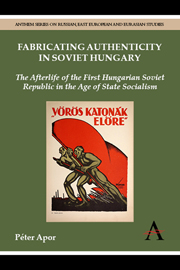 Fabricating Authenticity in Soviet Hungary
Fabricating Authenticity in Soviet Hungary Book contents
- Frontmatter
- Contents
- Acknowledgements
- List of Illustrations
- List of Abbreviations
- Introduction
- Chapter 1 Prefiguration: The First Hungarian Soviet Republic and the Rákosi Dictatorship before 1956
- Chapter 2 Resurrection: The Emergence of 1919 and the Counterrevolution after 1956
- Chapter 3 Lives: 1919 in the Postwar Trials of War Criminals
- Chapter 4 Funeral: The Birth of the Pantheon of the Labour Movement in Budapest
- Chapter 5 Narration: History, Fiction and Proof in the Representation of the First Hungarian Soviet Republic, 1959–65
- Epilogue The Agitators and the Armoured Train
- Index
Chapter 2 - Resurrection: The Emergence of 1919 and the Counterrevolution after 1956
Published online by Cambridge University Press: 05 April 2014
- Frontmatter
- Contents
- Acknowledgements
- List of Illustrations
- List of Abbreviations
- Introduction
- Chapter 1 Prefiguration: The First Hungarian Soviet Republic and the Rákosi Dictatorship before 1956
- Chapter 2 Resurrection: The Emergence of 1919 and the Counterrevolution after 1956
- Chapter 3 Lives: 1919 in the Postwar Trials of War Criminals
- Chapter 4 Funeral: The Birth of the Pantheon of the Labour Movement in Budapest
- Chapter 5 Narration: History, Fiction and Proof in the Representation of the First Hungarian Soviet Republic, 1959–65
- Epilogue The Agitators and the Armoured Train
- Index
Summary
Having succeeded the suppression of the revolution in October 1956, the first time that the new Communist regime evoked the events of 1919 was likely in the 21 November issue of the Népszabadság (People's freedom), the party's official daily. That day the editors published a letter, which had allegedly been sent to the government by an old worker. The author of this letter first gives an account of his life spent within the labour movement since 1917. The worker writes about his sufferings and privation during the previous regime, then recalls the happy years following the end of the war. The author then condemns the pre-1956 Communist leadership for distancing itself from the workers and their real life. He concludes that although the behaviour of the party elite contributed to the outburst of the rightful discontent in late October 1956, this was very soon appropriated by the ‘bloody counterrevolution’. However, considering the fact that the worker's memories reflect the ideal Communist interpretation of history as well as the official depiction of the revolt in 1956 taking shape at that time, it is very probable that the ‘old worker’ is an editorial invention. ‘He’ creates a remarkable historical parallel when he reminds his comrades of the peril: ‘Remember the bloody and cruel counterrevolution of 1919. Remember how many thousands and thousands of our innocent fellow workers and comrades met their death as martyrs, how many widows and orphans mourned their breadwinners and over many years how madly we were persecuted.
- Type
- Chapter
- Information
- Fabricating Authenticity in Soviet HungaryThe Afterlife of the First Hungarian Soviet Republic in the Age of State Socialism, pp. 61 - 100Publisher: Anthem PressPrint publication year: 2014
